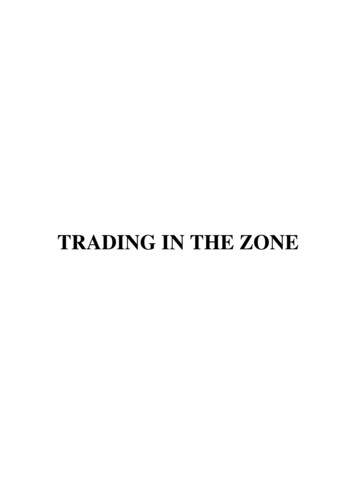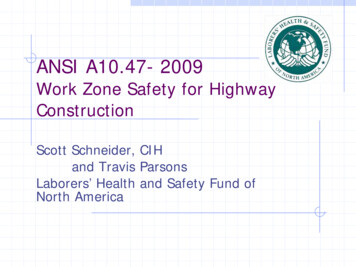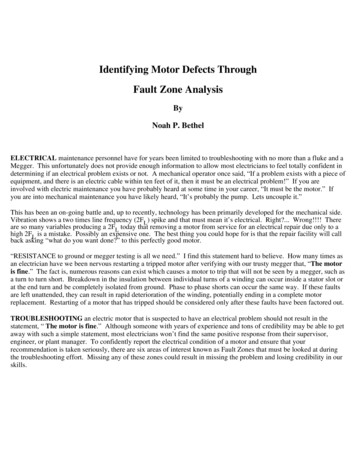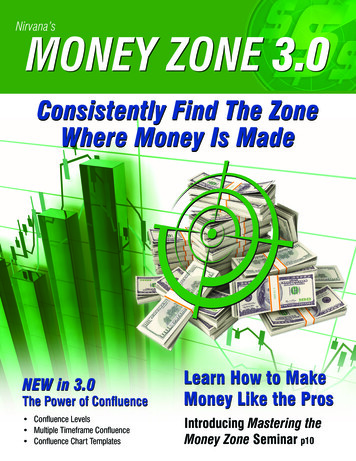
Transcription
TRADING IN THE ZONE
MASTER THE MARKET WITHCONFIDENCE, DISCIPLINE ANDA WINNING ATTITUDEMARK DOUGLASForeword by Thorn HartleNEW YORK INSTITUTE OF FINANCEwcw VHDV Tnnnurn . cvnucv Tnrvn cinr.«pnpcLibrary of Congress Cataloging-in-Publication DataDouglas, Mark (Mark J.)Trading in the zone : master the market with confidence, discipline, and awinning attitude / by Mark Douglas,p. cm.ISBN 0-7352-0144-7 (cloth)1. Stocks. 2. Speculation. I. Title.HG6041 .D59 2001332.64—dc21 00 045251 2000 by Prentice HallAll rights reserved. No part of this book may be reproduced inany form or by any means, without permission in writing fromthe publisher.Printed in the United States of America10 9876 5 4321This publication is designed to provide accurate and authoritativeinformation in regard to the subject matter covered. It is sold with the understandingthat the publisher is not engaged in rendering legal, accounting, or
other professional service. If legal advice or other expert assistance is required,the services of a competent professional person should be sought. . . From the Declaration of Principles jointly adopted by aCommittee of the American Bar Association and a Committeeof Publishers and Associations.ISBN D-73SE-DmM-7ATTENTION: CORPORATIONS AND SCHOOLSPrentice Hall books are available at quantity discounts with bulk purchase for educational,business, or sales promotional use. For information, please write to: Prentice Hall,Special Sales, 240 Frisch Court, Paramus, N] 07652. Please supply: title of book, ISBN,quantity, how the book will be used, date needed.NEW YORK INSTITUTE OF FINANCEAn Imprint of Prentice Hall PressParamus, NJ 07652http://www.phdirect.comNYIF and NEW YORK INSTITUTE OF FINANCE are trademarks of ExecutiveTax Reports, Inc. used under license by Prentice Hall Direct, Inc.
DEDICATIONThis book is dedicated to all of the traders I have had the pleasure of working with over the last 18years as a trading coach. Each of you in your own unique way is a part of the insight and guidance thisbook will provide to those who choose to trade from a confident, disciplined, and consistent state ofmind.
oTABLE OF CONTENTSFOREWORD . . . . . . . . . . . . . . . . . . . . . . . . . . . . . . . . . . . . xiPREFACE . . . . . . . . . . . . . . . . . . . . . . . . . . . . . . . . . . . . . . xmATTITUDE SURVEY . . . . . . . . . . . . . . . . . . . . . . . . . . . . . . xviiCHAPTER 1THE ROAD TO SUCCESS:FUNDAMENTAL, TECHNICAL,OR MENTAL ANALYSIS?IN THE BEGINNING: FUNDAMENTAL ANALYSIS . . . . . . . . . . 1THE SHIFT TO TECHNICAL ANALYSIS . . . . . . . . . . . . . . . . . 3THE SHIFT TO MENTAL ANALYSIS . . . . . . . . . . . . . . . . . . . 4CHAPTER 2THE LURE (AND THE DANGERS)OF TRADINGTHE ATTRACTION . . . . . . . . . . . . . . . . . . . . . . . . . . . . . . . . 17THE DANGERS . . . . . . . . . . . . . . . . . . . . . . . . . . . . . . . . . . 20THE SAFEGUARDS. . . . . . . . . . . . . . . . . . . . . . . . . . . . . . . . 25Problem: The Unwillingness to Create Rules. . . . . . . 27
Problem: Failure to Take Responsibility . . . . . . . . . . 28Problem: Addiction to Random Rewards . . . . . . . . . 30Problem: External versus Internal Control. 31CHAPTER 3TAKING RESPONSIBILITYSHAPING YOUR MENTAL ENVIRONMENT. . . . . . . . . . . . . . . 34REACTING TO LOSS . . . . . . . . . . . . . . . . . . . . . . . . . . . . . . 38WINNERS, LOSERS, BOOMERS, AND BUSTERS . . . . . . . . . . 50CHAPTER 4CONSISTENCY: A STATE OF MINDTHINKING ABOUT TRADING . . . . . . . . . . . . . . . . . . . . . . . . 58REALLY UNDERSTANDING RISK. . . . . . . . . . . . . . . . . . . . . . 61ALIGNING YOUR MENTAL ENVIRONMENT . . . . . . . . . . . . . . 64CHAPTER 5THE DYNAMICS OF PERCEPTIONDEBUGGING YOUR MENTAL SOFTWARE . . . . . . . . . . . . . . . 70PERCEPTION AND LEARNING . . . . . . . . . . . . . . . . . . . . . . . 74PERCEPTION AND RISK . . . . . . . . . . . . . . . . . . . . . . . . . . . . 79THE POWER OF ASSOCIATION. . . . . . . . . . . . . . . . . . . . . . . 80CHAPTER 6THE MARKET'S PERSPECTIVETHE "UNCERTAINTY" PRINCIPLE . . . . . . . . . . . . . . . . . . . . 88THE MARKET'S MOST FUNDAMENTAL CHARACTERISTIC. . 93
CHAPTER 7THE TRADER'S EDGE: THINKING IN PROBABILITIESPROBABILITIES PARADOX: RANDOM OUTCOME, CONSISTENT RESULTS. . . . 102TRADING IN THE MOMENT. . . . . . . . . . . . . . . . . . . . . . . . . 106MANAGING EXPECTATIONS . . . . . . . . . . . . . . . . . . . . . . . . . 113ELIMINATING THE EMOTIONAL RISK . . . . . . . . . . . . . . . . . 120CHAPTER 8WORKING WITH YOUR BELIEFSDEFINING THE PROBLEM . . . . . . . . . . . . . . . . . . . . . . . . . . 125DEFINING THE TERMS . . . . . . . . . . . . . . . . . . . . . . . . . . . . 128HOW THE FUNDAMENTAL TRUTHS RELATE TO THE SKILLS . . . . . . . . . . . . . . . . . . . 130MOVING TOWARD "THE ZONE". . . . . . . . . . . . . . . . . . . . . . 135CHAPTER 9THE NATURE OF BELIEFSTHE ORIGINS OF A BELIEF. . . . . . . . . . . . . . . . . . . . . . . . . 139BELIEFS AND THEIR IMPACT ON OUR LIVES . . . . . . . . . . . 142BELIEFS vs. THE TRUTH. . . . . . . . . . . . . . . . . . . . . . . . . . . 147CHAPTER 10THE IMPACT OF BELIEFS ON TRADINGTHE PRIMARY CHARACTERISTICS OF A BELIEF . . . . . . . . . . 153SELF-EVALUATION AND TRADING . . . . . . . . . . . . . . . . . . . . 167CHAPTER 11THINKING LIKE A TRADERTHE MECHANICAL STAGE. . . . . . . . . . . . . . . . . . . . . . . . . . 173THE ROLE OF SELF-DISCIPLINE. . . . . . . . . . . . . . . . . . . . . 179CREATING A BELIEF IN CONSISTENCY . . . . . . . . . . . . . . . . 184EXERCISE: LEARNING TO TRADE AND EDGE LIKE ACASINO . . . . . . . . . . . . . . . . . . . . . . . . . . . . . . . . . . . . . . . 189
A FINAL NOTE . . . . . . . . . . . . . . . . . . . . . . . . . . . . . . . . . . 201ATTITUDE SURVEY . . . . . . . . . . . . . . . . . . . . . . . . . . . . . . . 203INDEX . . . . . . . . . . . . . . . . . . . . . . . . . . . . . . . . . . . . . . . . 209
FOREWORDThe great bull market in stocks has led to an equally great bull market in the number of bookspublished on the subject of how to make money trading the markets. Many ideas abound, some good,some not, some original, some just a repackaging of earlier works. Occasionally, though, a writercomes forward with something that really sets him or her apart from the pack, something special. Onesuch writer is Mark Douglas. Mark Douglas, in Trading in the Zone, has written a book that is theaccumulation of years of thought and research—the work of a lifetime—and for those of us who viewtrading as a profession, he has produced a gem.Trading in the Zone is an in-depth look at the challenges that we face when we take up the challenge oftrading. To the novice, the only challenge appears to be to find a way to make money. Once the novicelearns that tips, brokers' advice, and other ways to justify buying or selling do not work consistently, hediscovers that he either needs to develop a reliable trading strategy or purchase one. After that, tradingshould be easy, right? All you have to do is follow the rules, and the money will fall into your lap.At this point, if not before, novices discover that trading can turn into one of the most frustratingexperiences they will ever face.This experience leads to the oft-started statistic that 95 percent of futures traders lose all of their moneywithin the first year of trading. Stock traders generally experience the same results, which is whypundits always point to the fact that most stock traders fail to outperform a simple buy and holdinvestment scenario.So, why do people, the majority of whom are extremely successful in other occupations, fail somiserably as traders? Are successful traders born and not made? Mark Douglas says no. What'snecessary, he says, is that the individual acquire the trader's mindset. It sounds easy, but the fact is, thismindset is very foreign when compared with the way our life experiences teach us to think about theworld.That 95-percent failure rate makes sense when you consider how most of us experience life, usingskills learned as we grow. When it comes to trading, however, it turns out that the skills we learn toearn high marks in school, advance our careers, and create relationships with other people, the skills weare taught that should carry us through life, turn out to be inappropriate for trading. Traders, we findout, must learn to think in terms of probabilities and to surrender all of the skills we have acquired toachieve in virtually every other aspect of our lives. In Trading in the Zone, Mark Douglas teaches ushow. He has put together a very valuable book. His sources are his own personal experiences as atrader, a traders coach in Chicago, author, and lecturer in his field of trading psychology.My recommendation? Enjoy Douglas's Trading in the Zone and, in doing so, develop a trader'smindset.
PREFACEThe goal of any trader is to turn profits on a regular basis, yet so few people ever really make consistentmoney as traders. What accounts for the small percentage of traders who are consistently successful?To me, the determining factor is psychological—the consistent winners think differently from everyoneelse.I started trading in 1978. At the time, I was managing a commercial casualty insurance agency inthe suburbs of Detroit, Michigan. I had a very successful career and thought I could easily transfer thatsuccess into trading. Unfortunately, I found that was not the case.By 1981, I was thoroughly disgusted with my inability to trade effectively while holding another job,so I moved to Chicago and got a job as a broker with Merrill Lynch at the Chicago Board of Trade.How did I do? Well, within nine months of moving to Chicago, I had lost nearly everything I owned.My losses were the result of both my trading activities and my exorbitant life style, which demandedthat I make a lot of money as a trader. From these early experiences as a trader, I learned an enormousamount about myself, and about the role of psychology in trading. As a result, in 1982, I startedworking on my first book, The Disciplined Trader: Developing Winning Attitudes.When I began this project I had no concept of how difficult it was to write a book or explain somethingthat I understood for myself in a manner and form that would be useful to other people. I thought it wasgoing to take me between six and nine months to get the job done. It took seven and a half years andwas finally published by Prentice Hall in 1990. In 1983, I left Merrill Lynch to start a consulting firm,Trading Behavior Dynamics, where I presently develop and conduct seminars on trading psychologyand act in the capacity of what is commonly referred to as a trading coach. I've done countlesspresentations for trading companies, clearing firms, brokerage houses, banks, and investmentconferences all over the world.I've worked at a personal level, one on one, with virtually every type of trader in the business, includingsome of the biggest floor traders, hedgers, option specialists, and CTAs, as well as neophytes As of thiswriting, I have spent the last seventeen years dissecting the psychological dynamics behind trading sothat I could develop effective methods for teaching the proper principles of success.What I've discovered is that, at the most fundamental level, there is a problem with the way we think.There is something inherent in the way our minds work that doesn't fit very well with thecharacteristics shown by the markets. Those traders who have confidence in their own trades, who trustthemselves to do what needs to be done without hesitation, are the ones who become successful. Theyno longer fear the erratic behavior of the market. They learn to focus on the information that helps them
spot opportunities to make a profit, rather than focusing on the information that reinforces their fears.While this may sound complicated, it all boils down to learning to believe that: (1) you don't need toknow what's going to happen next to make money; (2) anything can happen; and (3) every moment isunique, meaning every edge and outcome is truly a unique experience. The trade either works or itdoesn't. In any case, you wait for the next edge to appear and go through the process again and again.With this approach you will learn in a methodical, non-random fashion what works and what doesn't.And, just as important, you will build a sense of self-trust so that you won't damage yourself in anenvironment that has the unlimited qualities the markets have.Most traders don't believe that their trading problems are the result of the way they think about tradingor, more specifically, how they are thinking while they are trading. In my first book, The DisciplinedTrader, I identified the problems confronting the trader from a mental perspective and then built aphilosophical framework for understanding the nature of these problems and why they exist.I had five major objectives in mind in writing Trading in the Zone:To prove to the trader that more or better market analysis is not the solution to his trading difficulties orlack of consistent results.To convince the trader that it's his attitude and "state of mind" that determine his results.To provide the trader with the specific beliefs and attitudes that are necessary to build a winner'smindset, which means learning how to think in probabilities.To address the many conflicts, contradictions, and paradoxes in thinking that cause the typical trader toassume that he already does think in probabilities, when he really doesn't.To take the trader through a process that integrates this thinking strategy into his mental system at afunctional level.(Note: Until recently, most traders were men, but I recognize that more and more women are joiningthe ranks. In an effort to avoid confusion and awkward phrasing, I have consistently used the pronoun"he" throughout this book in describing traders. This certainly does not reflect any bias on my part.)Trading in the Zone presents a serious psychological app
Trading Behavior Dynamics, where I presently develop and conduct seminars on trading psychology and act in the capacity of what is commonly referred to as a trading coach. I've done countless presentations for trading companies, clearing firms, brokerage houses, banks, and investment conferences all over the world. I've worked at a personal level, one on one, with virtually every type of .Cited by: 1Page Count: 143File Size: 732KBAuthor: Mark Douglas, Thom Hartle











